
The Quest for Planet X
In 1906, famed astronomer Percival Lowell observed strange motions in Neptune’s orbit and predicted that these were caused by a missing planet beyond Neptune. He then began searching for this planet. Lowell searched for a decade for a ninth planet, and, unfortunately, died before it was found.
In 1929, a young farmhand named Clyde Tombaugh was hired at Lowell Observatory in Arizona to continue this search. In early 1930, Tombaugh discovered a planet in the observatory’s photographs! So, why did it take twenty-four years to find an entire planet? It turns out, the strange motions of Neptune’s orbit did not exist. Percival Lowell made a mathematical error. Nevertheless, Tombaugh’s object was completely real. The new object, named Pluto, was much too small to ever disturb the orbit of Neptune. Tombaugh had been searching for an object six times the mass of the Earth, and Pluto is actually smaller than the Earth’s moon; this was not exactly what Tombaugh had been searching for.

Pluto was considered the ninth planet—and the fifth terrestrial planet—for the next 76 years. However, it was such an odd planet that astronomers usually talked about it separately. The other four terrestrial planets (Mercury, Venus, Earth, and Mars) all follow nearly circular orbits close to the Sun. Their orbits lie in the plane of the solar system and only Earth has a substantial moon. Pluto, on the other hand, has a highly elliptical orbit that sometimes brings it within Neptune’s orbit, making Neptune the most distant planet. In addition to being so elliptical, Pluto’s orbit is not flat in the plane of the solar system, but highly inclined at 17 degrees.

It also is not in the inner solar system, where the rest of the terrestrial planets are found. When Pluto’s largest moon, Charon, was discovered in 1978, it was found to be about half the size of the planet itself. Pluto clearly didn’t fit the mold of the other terrestrial planets.
In the early 2000s, more objects were being discovered in the distant solar system. One of them, Eris, looked to be about the same size as Pluto. Astronomers wrestled with the question of whether Eris was the tenth planet. As more objects similar to Pluto were discovered, astronomers decided these “plutoids” were not additional terrestrial planets. They seemed to make up a debris ring similar to the asteroid belt. In fact, such a debris belt had already been predicted by astronomer Gerard Kuiper as the home to the solar system’s recurring comets. Now named after him, the Kuiper Belt starts near the orbit of the giant planet Neptune. Accordingly, objects that orbit on the inner edge of the Kuiper Belt are sometimes called trans-Neptunian objects.

Redefining Planethood
In order to deal with all the newly found objects in the outer solar system, astronomers decided to define some new classes of objects and also clarify what constitutes a planet. So, in 2006, three rules were created to assess whether an object is considered a major planet.
A planet
- orbits the Sun,
- is large enough to pull itself into a spherical shape through gravity,
- dominates the area of its orbit.
Pluto does orbit the Sun and is spherical, but because it shares its orbit with other objects of similar size, it is not a major planet. Objects that fit parts 1 and 2 of the definition but not part 3 were grouped together in a new category called “dwarf planets.” To date, there are five objects that fit this definition. Four of them are found in the Kuiper Belt, while one, Ceres, is in the asteroid belt. Ceres was also once considered a major planet before the rest of the asteroid belt was discovered. There may be other major planets yet to be discovered beyond the Kuiper belt, but so far we have not made observations of any more.
Pluto helped astronomers realize that the previous categories were not useful for describing the solar system and the scientific definitions had to change. This, of course, makes Pluto no less interesting—in fact, as one of the first dwarf planets, astronomers were eager to study Pluto to learn more about dwarf planets.
Toward that end, NASA launched the New Horizons spacecraft in 2006.
In order to get from Earth to distant Pluto in a reasonable timeframe, New Horizons had to travel fast: around 50,000 kilometers per hour. It finally arrived at Pluto in 2015, but the downside of its speed is that the spacecraft had only one day to photograph Pluto and Charon, as well as Pluto’s four other moons, as it sped by. Now, New Horizons is sending back data on the conditions of the outer solar system and the Kuiper belt.
Pluto’s Peculiarities
Almost everything we now know about Pluto and its moons comes from a single day of measurements and data collection done by New Horizons. The spacecraft took so much data during that one day that it took months to send it all back to Earth by radio. When all the images were in, they showed that Pluto has a dynamic landscape with many different features.

There are smooth plains, mountains, ridges, and valleys. Many of these landscapes are still not understood. One of the main differences between Pluto and similar landscapes on the terrestrial planets is that Pluto’s landscape is shaped in ice. At Pluto’s distance from the Sun, the planet stays around -370 degrees Fahrenheit (50 Kelvin, -220 degrees Celsius). The surface is largely frozen nitrogen, carbon monoxide ice, methane ice, and water ice. Water ice can float on top of nitrogen ice, forming mountains. At the cold temperatures far from the Sun where Pluto orbits, these ices are as hard as rock.
Despite the preponderance of ice, the landscape is not frozen in time, but moving. Pluto’s surface shows glaciers as well as regions where ice is slowly churning from a warmer interior. The bright “heart” of Pluto, named Sputnik Planitia, is one such basin of white nitrogen ice that is being slowly overturned from underneath, erasing any sign of craters.
Pluto also has a very light atmosphere that only manifests when Pluto is closest to the Sun and there is just enough solar energy for some of the gases on the surface to sublimate. This atmosphere gets deposited back on the surface when Pluto is at its farthest from the Sun.
Charon, Pluto’s largest moon, is half the size of Pluto at 1,200 kilometers in diameter. For this reason, astronomers sometimes consider them a double planet or binary planet system. Both of these objects are tidally locked, meaning their mutual gravity keeps the same sides always facing each other.
Charon also has an interesting surface. It appears to have a dark red polar cap. It has rift valleys caused by tectonic stresses, many of which appear as a belt near its equator. North of these tectonic valleys, the surface is smoother than in the cratered south. The compositions and origins of these surface features are still being studied. Pluto has four more moons, but these are truly tiny, about 20 to 60 kilometers in diameter. They are Styx, Nyx, Kerberos, and Hydra.
There is still much astronomers don’t know about Pluto and its moons. Its distance from the Sun means that it receives very little sunlight. This also means it can reflect very little light back to us. The dimness of the dwarf planet in telescopes is one of the many challenges astronomers are trying to overcome in an effort to better understand Pluto. One of the reasons that the public is so interested in Pluto comes from its change in status from major planet to dwarf planet. This change is symbolic of the fact that good science requires learning, growing, and adapting to new information. What other mysteries may wait for us on the outer edges of the solar system? Only time will tell.
Thanks for watching and happy studying!
